GENETIC TERMINOLOGY
- Genetics, the scientific study of heredity and variation in all living organisms, was termed by Dilliam Bateson in 1906.
- Heredity/Inheritance pertains to the passage and manifestation of traits from parents to offspring, accounting for the common resemblances between them.
- Variation encompasses the dissimilarities existing among parents, offspring, and siblings.
- Genes are hereditary units located on chromosomes, responsible for transmitting traits from parents to offspring. Coined “genes” by Johannsen in 1909.
- Chromosomes are thread-like structures within cell nuclei, housing genes.
- Characters denote inheritable attributes possessed by organisms, such as height, complexion, and colour.
- Gamete is a mature sex cell participating in sexual reproduction. Examples include pollen grains, ovules, sperms, and ova. Gametes are typically haploid.
- Zygote, a single cell, forms upon the fusion of male and female gametes. It is diploid.
- Allelomorphs (alleles) are gene pairs on specific chromosome positions, controlling contrasting traits.
10.A Locus denotes the gene’s location on a chromosome.
Table of Contents
- Genotype encompasses an individual’s inherited genetic makeup from both parents, comprising dominant and recessive traits.
- Phenotype encompasses all observable traits of an organism, encompassing physical, physiological, and behavioural characteristics.
- A Dominant trait is expressed in offspring resulting from parents with different traits. It is governed by a dominant gene (e.g., Tt).
- A Recessive trait remains hidden when a dominant trait is present. It is regulated by a recessive gene.
- Homozygous refers to an individual with identical genes for a specific trait (e.g., TT or tt).
- Heterozygous refers to an individual with differing alleles at a gene locus (e.g., Tt).
- Filial generations encompass the offspring of parent organisms, denoted as F1, F2, F3, and so on, with each generation leading to the next.
- A Hybrid results from the crossbreeding of genetically distinct parents of the same species.
- Hybridization involves mating plants with differing traits, encompassing monohybridization (crossing two pure traits) and dihybridization (crossing two pairs of contrasting traits).
- Haploid organisms possess one set of chromosomes in their gametes (23 in humans), represented as “n.”
- Diploid organisms possess two sets of chromosomes in somatic cells (46 in humans), represented as “2n.”
- Mutation refers to genetic changes in an organism, leading to new inheritable characteristics.
HEREDITARY VARIATION AND CAUSES
Hereditary variation denotes differences among individuals transmitted from parents to offspring, except in identical twins. It arises due to:
- Genetic reshuffling during meiosis, involving independent assortment and segregation, resulting in novel combinations.
- Crossing over during meiosis, where chromatids exchange genetic material, causing variation.
Transmittable characters in animals encompass physical traits (e.g., body stature, skin color), genetic conditions (e.g., sickle cell anemia), and sensory abilities (e.g., taste).
Transmittable characters in plants include traits related to growth, fruit, leaf, color, disease resistance, and more.
Transmission of characters occurs through genes. Diploid organisms produce haploid gametes through meiosis. Upon fertilization, gametes fuse into diploid zygotes, each containing two gene copies.
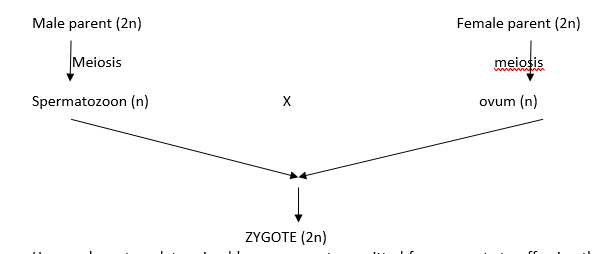
Hence, characters determined by genes are transmitted from parents to offspring through gamete
MENDEL’S WORK IN GENETICS
In the study of genetics, Gregor Mendel (1866) worked with the garden pea
(Pisumsativum) because of three unique properties present in it. These are
- Peas are self-pollinating
- They have a very short lifespan
- They have several unique genetic characteristics e.g. round or wrinkled seeds, tallness or shortness, seeds /pods/ flowers colouration, pod texture etc.
The Mendel’s methods of studying genetics are two:
- Monohybrid inheritance
- Dihybrid inheritance
Monohybrid inheritance
Mendel crossed two different plants which differ in one pair of contrasting characters e.g. tall and short plants. The procedures he followed are as follows:
- He planted tall plants for several generations and got all tall plant offspring. Likewise, the short plants he planted yielded all short plant offspring.
- He then planted tall and short plants. When the flowers were produced, he cross pollinated the pollen grains (male gamete) of the tall plant with the stigma (female gamete) of the short plant.
- He then planted the seeds of the cross in the procedure (ii) above and obtained all tall plants. This he called the first filial generation(F1,)
- He then crossed the F1 plants, collected their seeds and sowed them. He got tall and short plant in ratio 3: 1. This he called second filial generation (F2)
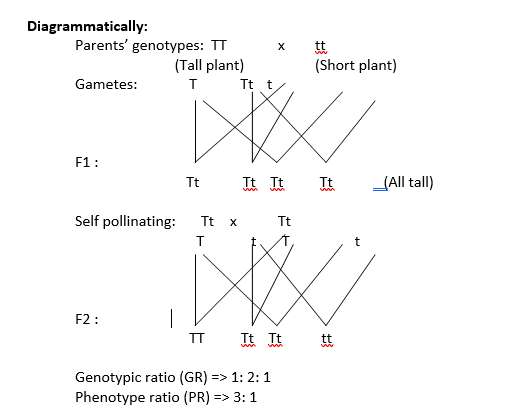
This experiment resulted into Mendel’s first law of inheritance which is based on the principle of complete dominance.
Mendel’s first law of inheritance
Mendel’s first law of inheritance otherwise known as the law of segregation of genes states that paired alleles segregate from each other when the homologous chromosomes on which they reside separate during meiosis. Each gamete receives one of the two alleles. The actual segregation occurs in F2 generation.
DIHYBRID INHERITANCE
Gregor Mendel crossed plants which differ in two pairs of contrasting characteristics e.g seed shape (round or wrinkled seeds) and seed colour (yellow or green seeds). He crossed plants having round and yellow seeds with these having wrinkled and green seeds. The F1 seeds were having round and yellow seeds. Self-pollinating F1 plants produced the F2 plants of four (4) types
- Round and yellow seeds : 9
- Wrinkled and yellow seeds : 3
- Round and green seeds : 3
- Wrinkled and green seeds : 1
This experiment resulted into Mendel’s second law of inheritance
Mendel’s second law of inheritance
Mendel’s second law of inheritance otherwise known as law of independent assortment of genes state that alleles of genes on different chromosomes assort independently during meiosis
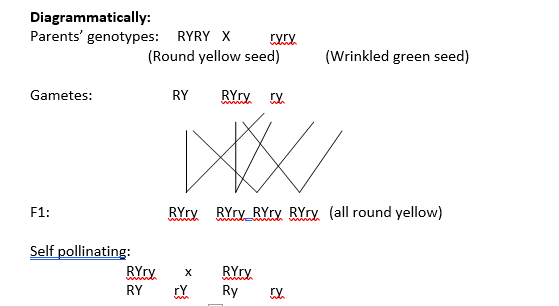
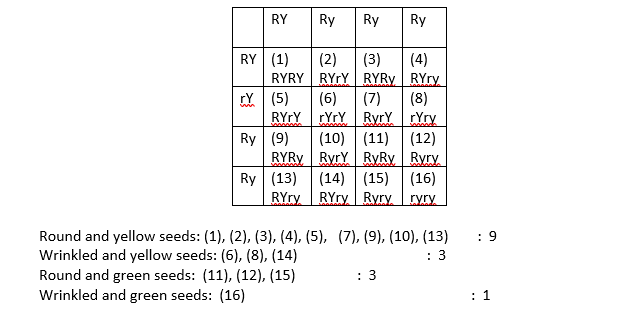
DETERMINATION OF THE GENOTYPE OF A DOMINANT PHENOTYPE
A dominant phenotype has the genotypic patterns RR, Rr. The genotype is determined using test cross or back cross
Test cross is the crossing of an organisms with an homologous recessive organism
Back cross is the crossing of an organism with an homologous recessive organism from the original parental generation
PRINCIPLE OF INCOMPLETE DOMINANCE
This deal with the ability of two contrasting alleles to interact and produce a heterozygous phenotype that is different from the two homologous phenotypes: Examples of organisms exhibiting incomplete dominance include: Mirabilisjalapa,4 o’clock plant, Audlausian fowl. This principle opposes Mendel’s principle of complete dominance.
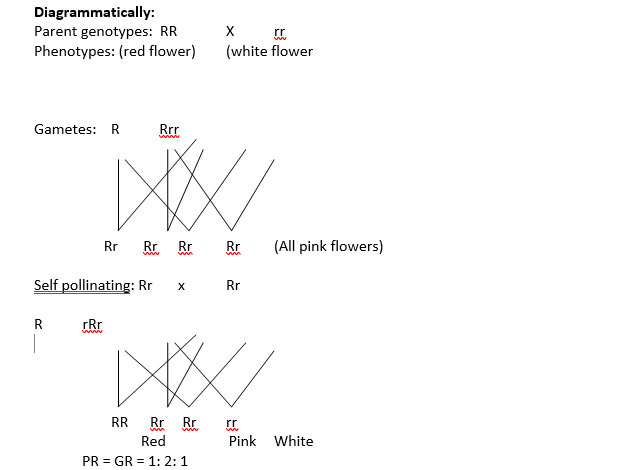
CO – DOMINANCE
In co-dominance, both alleles in the heterozygous individuals are fully expressed. The effect of one is not modified by the presence of the other. Therefore, three distinct phenotypes are produced e.g Inheritance of human “ABO” blood group

Allele 1A implies the addition of antigen A to the cell surfaces of red blood cells resulting in a person with group A blood. Likewise Allele 1B implies the addition of antigen B to the cell surfaces of red blood cells resulting in a person with Group B.
In a heterozygous individual, (1A 1B) both antigens A and B are added to the cell surfaces of red blood cells. So the individual has blood group AB.
NOTE: 1A and 1B are co-dominants while 1Ois recessive.
Multiple alleles
Genes that have more than two alleles in the population are said to have multiple alleles e.g. the human ‘ABO’ blood grouping
Sex determination in human beings
Each body cell of human beings has 23 pairs (46) of chromosomes, 22 of which are autosomes and a pair is sex chromosome. In male the two sex chromosomes in each body cell are X and Y chromosomes, therefore, each male gamete carries either X or Y chromosome. In the female, all egg cells of the body contain two X chromosomes. Therefore all egg cells contain one X chromosomes each. At fertilization, the combinations of an egg with a sperm carrying either X or Y chromosome occurs by chance. The formation of a male or female offspring has equal chances as shown below parents:
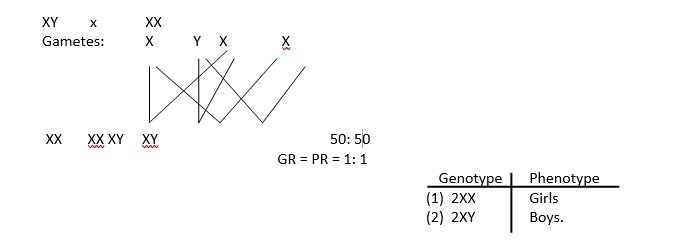
LOCATION AND STRUCTURE OF CHROMOSOMES
Chromatin granules (thread – like structures) found in the nucleus of eucaryotic cells are the precursors or raw materials of chromosomes.
Chromosomes occur in pairs known as homologous chromosomes. Each chromosome is made up of two threads called chromatids joined at a point called centromere. Each human somatic cell has 46 chromosomes. These are present in 23 pairs of homologous chromosomes. The number of chromosomes in each somatic cell of an organism is called diploid number (2n).
Each chromosome is made up of protein units in a strand of deoxyribonucleic acid, DNA (in double helix). Along its length are genes arranged which are actually DNA segments. The DNA is a very large molecule made up of repeating units called nucleotides. Each nucleotide is made up of deoxyribose (a sugar molecule), phosphate and an organic nitrogenous base which may be adenine, guanine, thymine or cytosine. Guanine always pairs with cytosine and adenine with thymine. The two helical chains are referred to as complementary strands of DNA since one is the exact opposite of the other.
Sex chromosomes and autosomes
There are forty-four autosomes which are similar in shape and size in both male and female. The last pair is called sex chromosome which are of genotype XX in female and XY in male. Exception to this is in birds, moths and butterfly where the female has genotype XY and the male XX. Also, in certain grasshoppers, the Y chromosome is absent so that the male has the genotype XO.
Just before cell division, the protein bundles come together and the DNA strands coil tightly around them, causing the chains to shorten and become visible under the light microscope. This process is called condensation
Each DNA molecule is made up of thousands of genes. The DNA molecules coil around the 23 pairs of chromosomes. In human body cells are about 50,000 genes. Each DNA molecule can make an exact copy of itself in a process called replication. This forms the basis for the transmission of hereditary materials from parents to the offspring.
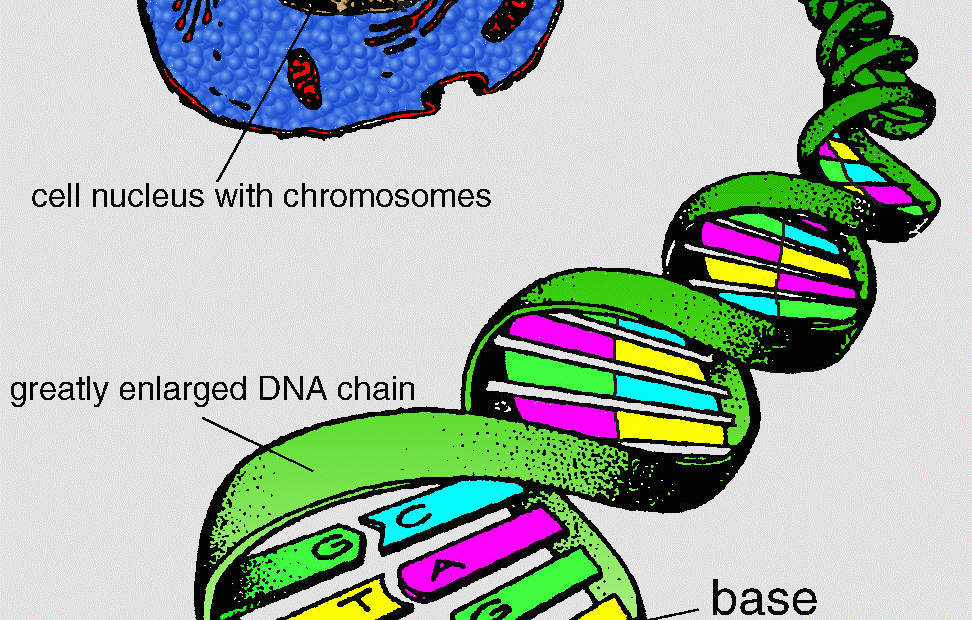
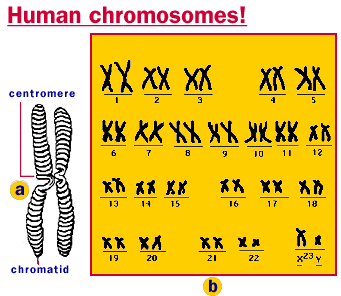
ROLE OF CHROMOSOME IN TRANSMISSION OF HEREDITARY CHARACTERS
Genes are the expression of hereditary characters in organisms and are located on the chromosomes of a body cells. Therefore chromosomes are responsible for the transmission of characters from parents to offspring. Chromosomes are arranged in pairs known as homologous chromosomes (exactly alike in shape and size and carry genes responsible for the transmission of the same characteristics). The genes relating to the same character e. g. tallness and shortness occupy identical loci on the homologous pair. The genes on homologous pair of chromosomes determine whether the individual will be homozygous or heterozygous for certain characters.
PROCESSES OF TRANSMISSION OF HEREDITARY CHARACTERS BY CHROMOSOMES
- The chromosomes pass the genes into the gamete during meiosis.
- Homologous chromosome separate into two daughter cells during the first stage of meiosis.
- The two chromatids of each chromosome separate during the second stage of meiosis. Each gamete therefore has one set of chromosomes hence one copy of genes.
- During fertilization, the gametes fuse together to form a zygote. The zygote receives two genes for the same character (one from one chromosome in the egg and the other from one chromosome in the sperm).
- When the two genes are the same, the offspring is a homozygous but when they are different, the offspring is a heterozygous (hybrid).
SEX-LINKED TRAITS
Sex–linked traits are characteristics whose genes are carried on the X chromosome of the sex chromosomes instead of autosomes. Such genes are inherited along with such X chromosomes. They are all controlled by a recessive gene. Examples of Sex-linked traits are: colour blindness, haemophilia, baldness, sickle cell anaemia and albinism.
- Colour blindness: A colour blind person cannot distinguish near colours. It is an abnormality of the gene that controls the production of cone cells (light receptors) in the retina of the eye.
- Haemophilia: This is a disorder in which bleeding takes an abnormally long time to stop or fails to stop because blood clotting will not occur. In haemophiliac (the victim) small injuries can result to bleeding to death e.g. Queen Victoria’s lineage (gene for haemophilia arose as a mutation in Queen Victoria or one of her parents) in British Royal Family.
- Baldness: The recessive gene controlling this trait causes the hair on the upper part of the head to pull out prematurely. It is more common in male human beings.
- Albinism: This is the condition in which the skin of an animal is non – pigmented because of lack of the pigment called melanin.
- Sickle cell anaemia: The recessive gene controlling this abnormality causes some of the red blood cells to be sickle shaped. The haemoglobin of the affected red blood cells is abnormally shaped thereby making it inefficient in transporting oxygen. In a condition of low oxygen concentration, the haemoglobin breaks down causing the cells to be sickle shaped. This then leads to the blockage of the cavities of the small blood vessels in the body thus hindering free flow of blood. The body part affected receives lower blood, oxygen and nutrients. Therefore, the victim goes into crisis at such periods characterized by pains in the bones and joints.
PROBABILITY IN GENETICS
Probability is usually expressed in units ranging from 0 – 1. Mendel’s works were based on probability.
Mathematically,
Probability = No of times an event occurs/Total no of trials
The two guiding principles of probability in genetics are:
- The result of one trial of a chanced event does not affect the result of latter trials of the same event.
- The chance that two independent events will occur together simultaneously is the product of their chances of occurring separately.
APPLICATIONS OF THE PRINCIPLES OF HEREDITARY
In agriculture
Genetics is relevant and has led to the following:
- Cross fertilization &self-fertilization procedures
- Development of early maturing varieties of organisms.
- Development of disease–resistant varieties of organisms.
- Production of crops and animals that can adapt to climatic conditions.
- Improvement of quality and quantity of product
In medicine
Genetics helps in the following:
- Determination of paternity of a child.
- Blood transfusion
- Diagnosis of diseases
- Sex determination
- Marriage counseling to avoid cases of genetic disorder.
- Knowing and choosing the sex of a baby.
- Development of test tubes babies.
NOTE: All the applications listed above sum up the relevance of biology to life in what is now termed biotechnology. In biotechnology the DNA is now being manipulated to the benefits of humanity i.e. genetic engineering.
Biotechnology
The various applications mentioned earlier collectively underscore the profound significance of biology in our lives, encapsulated by the overarching field known as biotechnology. Within this dynamic realm, DNA manipulation has emerged as a pivotal tool for the betterment of humanity, exemplified by the remarkable field of genetic engineering.
Biotechnology, as a discipline, represents the fusion of biological principles with technological innovation, fostering a synergy that has transformed the way we interact with the natural world. This amalgamation of knowledge and cutting-edge techniques has opened up a vast array of possibilities for addressing some of our most pressing challenges and advancing the frontiers of science.
Central to the advancements in biotechnology is the manipulation of DNA, the fundamental code of life itself. Genetic engineering, a cornerstone of this field, involves the deliberate modification of an organism’s genetic makeup to achieve specific outcomes. It is an ingenious approach that harnesses the inherent information encoded in DNA to bring about beneficial changes, whether in the realm of medicine, agriculture, or beyond.
In the context of genetic engineering, the potential benefits to humanity are manifold. In medicine, it has paved the way for the development of groundbreaking treatments and therapies, from gene therapy for hereditary diseases to the creation of genetically modified organisms to produce pharmaceuticals. In agriculture, genetically engineered crops have the potential to increase yields, enhance nutritional content, and reduce the need for harmful pesticides, thereby addressing food security challenges on a global scale.
Moreover, genetic engineering offers promise in environmental conservation, enabling the creation of organisms capable of bioremediation and pollution control. It also holds the key to understanding and addressing the complexities of ecosystems and biodiversity, offering insights into the preservation of fragile ecosystems and endangered species.
Biotechnology has emerged as a powerful conduit through which our understanding of biology converges with technological prowess. At its core, genetic engineering exemplifies how the manipulation of DNA has become an instrumental tool for improving the quality of human life, ushering in a new era of innovation, progress, and hope for a brighter future. It represents the embodiment of humanity’s enduring quest to harness the secrets of biology for the betterment of all.
See also:
Reproductive Behaviours: Courtship Behaviour, Display of Colours & Seasonal Migration
Fruits : Types, Structure, Dispersal of Fruits, Agents of Dispersal of Fruits
The Eyes | Anatomy, Functions, Problems, Solutions, Symptoms or Signs, Care For Eyes
Seeds | Zygotes, Conditions for Seed Germination, Formation & Seeds Germination
Reproductive System and Reproduction in Humans